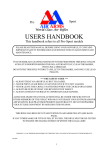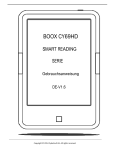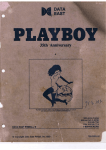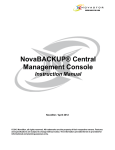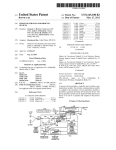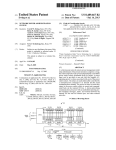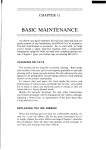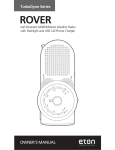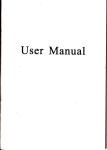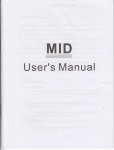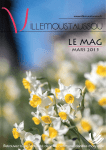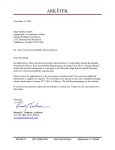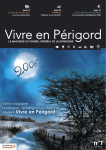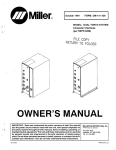Download St._Paul_CC_Jan_1984
Transcript
S~
COMPUTER
PAUL
COMPUTER
UPGRADE~
RATE
CENTER
CHANGES
Ch December 30, 1983, SPCC 's IHM 4341 central processor was upgraded from ct m:rlel Ll
to a Ml2. rrhe upgrade consisted minly of two sign1ficant improvements:
a) an 80% increctse in processing power (cycle time), and
b) an increase of 4 megabytes (mill1on) of memory bringing the system
total to 8 megabytes.
Over the weekend of January lst the new system was benclunarked against its predecessor.
Comparative performance checks were done on the three operating systems
(COS/VSE, l\1USIC and G1S (includes SAS)). After sununarizing findings it was ascertalned that the central processor performance had, on an average, improved slightly
ITDre than ITDre 80% across the board. Hence, the new rate of $9.00 per minute for
central processing was established. 'Ihis new rate assures that computing will not
increase for users as a result of the system upgrade.
'Ihrcugh the integration of virtual and overhead central processor time 1nto our
charging algorithm, a further improvement has been mde for aviS users. Here users
will experience an approximate 20% improvrnent on cost/performance (more so, on products such as I::fli.IAD, PROFS and SCRIP"r).
Mdtional Rate Changes
1. Differential Off-Hour Rates .................................... .
Effect1ve January 1, 1984, SPCC instituted differential off-hour rates for work
done cutside the prime shift. Computer processing performed after 5:00 pm daily
(Monday thru Friday) and all Saturday processing will be eligible for these
reduced rates. Users doing their processing during these off-hours will rece1ve a
25% reduction on three billable components:
Central Processor T1me, High Speed
Input/Output (d1sk and tape), and Connect 'I'lme.
Off-hour differential rates are shown below:
Un1versity Accounts ......... .
New Rate
Computer Resource
Central Processor
Disk/Tape I/O
Connect Time
SPCC
Standard
Charge
-------$9.00
$.0012
$2.00
January 1984 Newsletter
New Rate
Off-Hour
Charge
-------$6.75
$.0009
$1.50
Page 1
S T.
P' A U L
C 0 MP U T E R
C E N T E R
Non-University Acccunts ..... .
N2w R:J.te
Computer Resource
Central Processor
Disk/Tape I/O
Connect Time
standard
Char9e
New Rate
Off-Hour
Charge
---·-~·--
--------
$12.00
$.0016
$2.75
$9.00
$.0012
$2.00
SPCC plans on installln9 a "BatCh fvbnitor" within the next few weeks to facilitate
'pr1me time' routing of batCh v-.ork for off-hour scheduled processing. Look for an
announcement regard1ng this on the CJvlS and MUSIC news tacilitie~.
2. Different1al D1sk Storage Rates ................................ .
Effective ,January 1, 1984, SPCC instituted dltterentia1 disk space rates wh1ch are
es}?ecially appllcabl.e to large disk space users.
Our standard d1sk storage
Charge, as you may recall, is $.000018/byte/rronth ($18.00/milllon bytes/rronth).
'Ihis rate still holds true for disk space utilization up to the establlshed
first-level ceil1n9 of 10 megd.bytes, then the rate lS decreased to $14. 00/millwn
lytes/rronth. This rate then holds true again unt1l the second-level ceillng is
red.Ched, etc. (see table b?.low).
N:lte: For accounting _purposes, disk space differential rate
b:J.sed on USERID (not account number).
= =======================:=
eliglbility Wlll be
====
Disk S.f:Xice
Differential Rate
Table
==============================
Differential
Category
Flrst 10
Next 15
Next 25
Next 50
>
l 00
Megabytes
Megabytes
Megabytes
Megabytes
Megabytes
r•lega.byt e
Rate
$18.00
$14.00
$10.00
$:6.00
$3.00
Illustration applying new rates
to various levels of disk space
utiliziation
A USERID having
25 megabytes of
d1sk space would be charged $180
for the first 10 megabytes and
$210 for the next 15 megabytes
(total Charged would be $390).
3. CM.S Archiving Rates ............................................ .
SPeC's CJv1S ardliv1ng rates have nCJ.tV been set and users td.king advantage of this
facillty Wlll be charged $3.00 per megabyte (or Jprtion thereof) stored _t)er rronth.
NJte: 'Ihis rate is a 83% reduction to the standard 'act1ve' disk space rate.
January 1984 Newsletter
Page 2
S 'r.
WINTER
P A t.1 L
QUARTER
C 0 M P t1 'I' E R
C E NT I R
COURSES
SHORT
The St. Paul Computer Center will be oifering the short courses shown
the winter quarter.
The User Orientation presentation introduces new
tive users to the SPCC fac1lity. Following a brief descript1on of the
software available at SPCC, a short tour of the computer center Wlll be
l:::.elow during
and prospechardware and
given.
'fue SAS course w1.ll cover the Statistical Analysis System (SAS), a cornprehensi ve
statist1cal l:Jackage available on the IBM 4341 computer at SPCC. In addition to statistics, SAS provides sottware tvols for data storage ill1d retrieval, report writing,
general programming, and graphics.
Beg1nning this quarter, a computer-based training package for SAS will be part of
the coorse.
Users not attending the short course may also have access to this
selt-stud.y course. Check with Michele Burlew to obtain IIDre information on its use
or to obtain the handout "Using CBT for SAS".
'Ihe MUSIC course will cover the J.VlcGill University System for Interactive Computing,
an interactive overating system called MUSIC. The MUSIC operating system allows one
to edlt and save files, submit batch JObs, or run JObs interactively.
'fue CMS course w1ll introduce the Conversat1onal Monitor System, an operating system
that allows one to edit and save files, submit batch JObs, and run Jobs interactively. 'lhe G'lS editor XEJjiT offers many rrore opt1ons ill1d capabilities than the ed1tor
for HUSIC. SAS and N:J'.1AD (a new data base 1Uill1agement system) may be accessed interactively through CMS.
The
~
demo introduces a Data Base .tv'.liillagement System now available at SPCC .
is a fourth generation language, whiCh may be used for data management,
retrievals, application programming, report writing, and grari1ics.
.N)M.A]j
All oourses will l::;e offered on the St. Paul campus.
the winter quarter is as follows:
'Ihe
short course schedule tor
SIDRT COURSE NAivlE
ffi'l'E
TIME
User Orientation
Introduction to CMS
Introduction to MUSIC
SAS (Statistical Analys1s System)
Introduction to CMS
Introduction to MUSIC
SAS (Statistical Analysis system)
Introduction to NOMAD
Feb
Feb
Feb
Feb
Feb
Feb
rvar
('Ih)
9
(M,W)
13,15
14,16
(T,Th)
20,22,24 (M,W,F)
28,Mar 1 (T,Th)
29,Mar 2 (W,F)
(M,W,F)
5, 7,9
(By arrangement)
3:00-5:00
3:00-5:15
3:00-5:15
3:00-5:15
3:00-5:15
3:00-5:15
3:00-5:15
The User Orientation will be held in B35 COB (St. Paul Campus), with no registration
required. Tb register for tl1e other courses shown above please obtain and complete
SPCC
January 1984 Newsletter
Page 3
S~
PAUL
COMPUTER
CENTER
a short c'Ourse registrat1on form from SPCC (373-0987; 50 Coffey Hall) and return it
to the main oftice, 50 Coftey Hall, prior to the start ot the class.
Most short
courses have a m:x:lest fee associated with them and require full payment before the
class begins. Sxry, no refunds are made after the class begins.
It you have questions abcut short courses,
.Mo:l Sauve or Diane Suski ( 3 73-0987).
their cost, or registration, please call
If yvu have a group of 6 or nvre people interested in any of the short courses, SPCC
can schedule a class JUSt for your group.
make the necessary arr.:mgements.
SAS
Please c'Ontact Mel
Sauve at 373-0987 to
NOTES
SAS Disk fvligratwn
'Ihe maJor change in ::hsk space utilization announced in our last newsletter ha.s been
delayed. 'Ihe d1ange Wl.ll ta.ke place during winter quarter. Users will l:::Je contacted
by SPCC staff when it is time to !Ulgrat~~.
SAS 82.3
SAS 82.3 has been install.ed at SPCC and will be available as the FUTURE version of
SAS by the time this newsletter is d1str1buted. In mid February, SAS 79.6 will
becane the past vers1on, and SAS 82.3 w1ll become the current version.
As
W2
mentioned 1n tl1e last newsletter, the documentation for the new vers1on 1s:
SAS User 1 s Guide:
SKS USer 1 s GU1de:
Basics, 1982 Edition
Stahst.ics, 1982 Edition
Some of the nevv procedLtres documented in SAS User 1 s Guide:
Basics are:
adds ob:;ervat.ions to the end of a SAS data set
produces
~iUITUlBry
and schedule calendars
prints labels and forms
(supplemental procedure added to 'Ihe SAS library)
produce:s descriptive stat1stics 1n tabular form
'liW.'Sl?OSE
Sl?CC
transposes a SAS data set
January 1984 Newsletter
Page 4
S~
PAUL
COMPUTER
CENTER
Some of the new features documented in SAS User's Guide:
Statistics are:
a new procedure for general purpose regression, 1ncluding diagnostics
a new procedure for response-surface regression
(supplemental procedure added to the SAS llbrctry)
GtM and ANJVA have many new means comparisons methods
a new procedure for principal components analys1s
(supplemental procedure added to the SAS library)
Srr!:PDISC
a new procedure for stepwlse discriminant analysis
(supplemental procedure added to the SAS llbrary)
a new procedure that prints tree diagrams of hierarchical clusterings
has been rewritten to use Ward's method, the centroid method, or the
average linkage on squared Euclidean d1stances method.
Two of these
methods can take far less space and CPU time to run than the method
implemented in SAS79.
MA'l'RIX
has several new functions.
Gra.LJhics
Users Who a.-m an IBM FC with the asyncronous conmtunlcations interface, the color
graphics interface and a color monitor may use their PC as a graphics terminal with
Si\S 82. 3. 'Ihe Si\S Intitute ha.s distributed a group of BASICA programs Which w1ll
turn the IBM PC into a graphics terminal 1n either h1gh or medlum resolution graphics modes. Images may be saved on d1sk and replayed at a later time. The device
drivers make good use of the higher level graphics capabilit1es of BASICA (lme,
circle, paint etc.). This results 1n short data transmission time for rrost images.
More deta1led wr1tten information will become available later. Users who would l1ke
to try this feature now should ask for information at the help desk.
CCMHJTER-BASED TRAINING NCW AVAilABLE FOR SAS
In February, St. Paul Computer Center is 1nstalling the CRW1'H computer-based training package for SAS. This 1s a self-study course that lets you review the fundamentals of SAS and learn some of its more advanced features. This is done by using a
computer-based training (CBT) system. With the CBT system, you are instructed in
SAS. You will be asked questions to both remforce the instruction and to give you
SPCC
January 1984 Newsletter
Page 5
S~
the "hands-on" teel
rrents and programs.
PAUL
of .us1ng SAS.
COMPUTER
.tvluch
CENTER
of the course 1nvolves
writing SAS state-
Information presentation under the CBrr system is given on the terminal. You log on
to the computer and invoke the CB'I' system when you have time available for
self-study. You are presented with narrC:tti ve text on the terminal screen or hardcopy terminal and,, when satisfied that you have understood the topic, you can move
ahead to the next topic.
'Ihe course is intended prj_ffi2trily for end users, non-data processing people who will
o.vn statistical analysis and/or rep::;rt writing. The length of the
course will depend upon v..het:her you are already familiar with SAS and can skip the
introductory sessions, and how deeply you need to go into Stili. Many of the later
sessions are elective, depending on your individual n.eeds.
be doing their
Use of the CB'I' system for SAS wi 11 be the basis of the Center ' s SAS short course
offering. !bwever, you do not need to attend the short course to use it. Check
with JVlichele Burlew to obtain more information on its use or to obtain the handout
"Us1ng Computer-Based Train2ng for SAS".
NOMAD
NEWS
As we announce::i in the last newsletter, Na'1AD is a cornprehensl ve database management
and report1ng language now available at SPCC under the CMS timesharing system.
Since its installat1on, numerous applications, large and small, have been irnplerrented. Users ina1cate tlBt they are flncang NCMAD easy to learn and use.
N:l-1AD offers many time saving tools that
rrer.
Some of the
procedw~e
generate NC'MAD procedures for the programgenerating tools are:
MAKEDUMP / MAKELDlill -- Generates
from external flles.
pr:ocedures to ournp
and load datalxtses
to and
IvlAKEFO.HM - Alla.vs interactive building of form descriptions.
MAKEM - Generates screen driven update procedures.
MAKEUP - Generates non-screen interactive maintenance procedures.
CHOICE - Used 1n
dures to run.
a procedure to produce screens to
'Ihese tools along with others are documented ln the
available in Room 50 0)ffey Hall for $3.00.
SPCC
January 1984 Newsletter
choose among various proce-
KMAD2 Tools Manual
whlch 1s
Page 6
S~
PAUL
COMPUTER
CEWTER
There is al::.o a ~2 Tutorial available for the begirming NC1v1AD user. The user IS
lea through sample terminal sessions using an education database and also in creating a new database.
This document introduces the LIST carnrrand and the basic database management commands in an easy to follow interactive style.
PROFS - ( PROFFSSIOOAL CFFICE SYSTEM)
Although PROF'S has been available to a number ot deparments for some time, SPCC has
JUSt Installed the newest release and is now making it available to Its entire
clientele.
To gain access to the PROFS software use the GET command as tollows:
get prots
PRUF'S provides a comprehensive and easy-to-use set of otflce automation functions
for the executive, professional and secretary. PROFS IS an Electronic Mail fac1llty
and much more. From a single terminal you can obta1n and d1stribute information
Wl th only
a few key strokes.
Other facili t1es of PROFS allow you to manage your
most valuable resource - your time.
PROFS Highlights:
1.
2.
SENDING MESSAGES Al'-JD NarES
Used to send short messages and notes to other PROFS users.
REVIEWING IN-BASKE'I' (INCCMING MAIL)
Used to read and handle your 1ncom1ng mail (electronic correspondence) received via PROFS.
3.
SCHEDULE APPOIN'JJVI.Em'S
Used to maintain your personal calendar. You may also view and/
or maintain the calendar of other PROFS users when author1zed to
do so. M::iy also be used for room scheduling.
4.
SE~~ING
REMINDERS
Used as an automatic fac1l1ty to remind you about upcoming meetings,
appo1ntments, etc.
5.
J.XX.:UMENT PHEPARATION
Used to create formal documents, memos, and letters and to send
them to other PROFS users.
6.
SEA.R::H MD RE'I'RIEVE rx:cuMENTS
Used to find and retrieve documents which you sent or received
from other PROFS users.
SPCC
January 1984 Newsletter
Page 7
S T.
7.
PA U L
C 0 MP U T E R
C E N T E R
IXX..'UMEN'l' PREPA.FATION .ZUlli
Has spelling Check:s, table of contents facih ty <:md a number of
other composltion ald:s.
8.
EXI'ENSIVE 'HELP FACILITY'
PROFS has an extensl ve '1IELP' facill ty built in ma.king it easy for
a user with no prevlous knuwledge of computers to productively use.
I
'Ib acquaint the user
available:
with PROFS and its operational use,
Getting Started with PROFS
Using PROFS
CLIM- New
S t a t i s t i c a 1
(SH2G-5602}
(SH20-5604)
Package
the following nanuals are
$13.50
$28.00
I n s t a 1 1 e d
Installed recently, CiliiM (Generalized Linear Interactive ~Ddeling) is a product distr it:uted by the Foyal Statistical Society in Oxford, England and is widely used
thrcughout the world. GLIM is a program designed to facilitate the fittlng of generalized linear rrcdels. It contains routlnes for specifylng and fitting desireci
rrcdels, reading data, transforming data, and displaying results through listings a.J.'ld
gra_tbic diagrams. Gl. . IM is available under CMS in lDt.Cl interactive and batch modes.
Ivbdel Fitting Facilides:
l.
2.
3.
4.
5.
6.
7.
8.
9.
10.
Linear regression with quantltative lndependent varlates.
Fitting line.ar m:::dels with factors and covan.ates.
Fitting and testing lc:-glinear or linear rrcdels for dlscrete data
including binomial or multinomial data and contingency tables with
res.fOnses and/or factors.
Linear rrcdels on a logit scale for multiway tables of proportH:ms.
Probit analysis of dose-resfOnse curves/surfaces.
Estimation of variance components from independent mean squares.
Inverse-polJ.momlal response surfaces with gamma errors.
fvbdels for survival data based on the exponential distribution.
Permits mixed quanti ta ti ve-quall ta ti ve terms in linear rrcdels to
enable separate, parallel or common regresslons to be ti tted.
Through transformations one can produce the right error structure
in the data and yet control the addi vi ty of fit ted ef tects.
Other Facllities:
l.
2.
SPCC
Input of Data ....... Fix or free format. r:ata may be entered lnteractively or may be previously stored.
Calculations ........ Arithrnetic cperations on vectors and scalars;
suffices; functions include pseudo-rando~nwtiber generator,
standard arithmetic ftmctions and relatlonal c:perators; sorting.
January 1984
NewslettE~r
Page 8
S T.
3.
4.
5.
1' A fJ L
C 0 M P U '1' ! R
C ! N 'l' I R
Scatter Plotting ..• Up to n1ne var1ates simulateously; automatic
scal1ng; selection of subsets.
Program control .... Def1nit1on and use ot macros as named blocks of
1nstructions; use ot macros in looping and branching; argument
substitution in macros.
Diagnostics ........ Extensive 1nternal d1ecks for faults; full
diagnosis illld suggested remedies.
'l'o acquaint the user with GLIM and 1ts operational use, the following is avallable:
Introductory Notes on GLIM (contains reference card) $3.50
The GLIM S'ystem User Manual
$16. 00
CMS Cbline Help Fac1llty {Type: "I-lELP lM GLIM")
N/C
SPCC
PUBLISHED
The following
docun~ntation
:&U'blication
DOCUMENTS
1s available from SPCC.
Coat
Deacription
MUSIC General User's
Reference Card
$ .50 A xeroxed version of the MUSIC SYSTEM Reference card, contain1ng a brief description of
the MUSIC ccmma.nds ( 5 pages) .
SA.S Seminar Handcut
$3.50 A SA.S handout filled with examples and illustrations showing how to use the DA~ step,
with its many statements, and many Proc steps
( 104 pages).
SA..S Procedures Handcut
$ .75 A list of the SAS procedures with a brief
description of the capability and use of each
(15 pages).
MUSIC SCRIPT Manual
$8. 00 An introduction to the MUSIC operating system and to SCRIPT' (126 pages).
MJSIC Pr1mer
$5.00 An introductory guide to assist users of the
MUSIC system (129 pages).
SPOC Bacil1ty Introduct1on
intrcductlon to the St. Paul Computer
Facil1ty (22 pages) - no charge.
An
CMS 0u1ck Reference Guide
$ .25 A brief summary list of many frequently
CMS and XEJJIT cOIIill.lilllds ( 3 pages) .
Beginner's Gu1de to CMS
-Full SCreen
$2. 00 An introduction to CMS for users who are connecting to the IBM system from a video dlsplay terminal. There are sample terminal
January 1984 Newsletter
used
Page 9
S T.
PA U L
C 0 M P U T E R
C E N T E R
sesslons along with explcmations of the displays (59 pages) .
$1.00 An intrcx:iuction to Qv.IS for users who are connecting tv the IJ3M system from a DEC Wr l ter,
H:l.zeltine, Data Media, or other Llne at a. Time
terminal (31 pages).
Beg umer 1 s Gulde to Qv1S
-Line at a 'rime
OMS Reference Guide
A sovn to be released guide to using CMS at
SPCC. This covers more material and in
sllghtly greater depth than the Begumer s
Guides. Price - not yet determined.
1
Guide to using the IBM PC
$ . 75
as a terffilnal to the IBM 4341
A guide to creating a boatable dlskette with
the programs necessary to use the IB~l PC as a
terminal to the 4341. Uploading and downloadlng files is also dlscussed (19 _pages).
NJ!VJAD Tutorial (Terminal
An easy to read and follow example on en ted
$2. 00
text of the basic NCJtv'JAD comirliillds for reporting and database creation (39 pages).
S=sslon/Films)
~/SP
Archival Storage
Subsystem User's Guide
For a complete llst of
Introduction.
STATISTICAL
$2.00
Provides an introduction to the A.FC:HIVE system available under CMS as well as documenting all ot the coJJUilClilds and options. A must
for serious users of the ABCHIVT~ system t27
pages).
the publications that are
available see the
SPCC Facility
CLINIC
'Ihe Statistical Center provides statistical consultin9 to researchers at the University ot Minnesota. The services ot the Center are available to the University community, generally without d1arge. Assistance on appropriate experimental designs
ane1 rrethods, data analysis, and the interpretation o:E results are part ot the mission ot the Center.
'Ihe Statistical Cllnic, located in room l25g, ClassrcX)m Office Building, on the St.
Paul Campus, is staffed by graduate students of the Sc..hool of Statistics, and supervised by faculty members of the Applied Statistics Department. I t is intended tv
provide an initial contact between the Center and students with research problems.
Many statlstical problems can be handled completely by the personnel in the Clinic;
however, rrore difficult problems will be referred to an Applied Statistics faculty
rrember.
SPec
January 1984 Newsletter
Page 10
PAUL
S~
COMPUTER
CENTER
The hours ot the Statist1cal Clinic for Fall Quarter 1983 are:
fvlonday
Tuesday
Wednesday:
Thursday
Friday
8:00-5:00
8:00-3:30
8:00-5:00
8:00-3:30
8:00-5:00
Room: l25g COB
Phone: 376-3845
ACCESS
T 0
Ii'ACILITIES
Sr PAUL c::cl'-1PUTER CENTBR
SPCC hours, locations and telephone numbers:
fvtu n Office
Users &Jam, and
Comvuter Hours (l):
Help L1ne and Desk
Hall 373-0987 8:00 am 7:00amHall
8.00 am Hall
Hall 376-4602 10:00 am 1:00 pm llita Entry
6 North Hall 376-9222 8:00 illn Interactive Dialup Number:
376-5820
90
90
90
90
Cot±ey
Cotfey
Cot fey
Coffey
4:30pm
10:00 pm M-F, and
4:00 pm Sat
12:00 pm
4:00pm
4:30pm
(l) After hour and Saturday access to the Center may be achieved
by using the tunnel passageway from the Student Center.
MBRITSS S'YSTEM
m~TION
'ID
SPCC
Users can now gain access to the IBM 4341 computer system at SPCC through tl1e MERITSS System. There are now six ports dedicated to this type of communicat1ons traffic. Those wishing to ut1lize this type of access can obtain the handout narr~a
"Using SPCC 's IBM Computer from the MERITSS System" from our main offlce (l page, no
d1arge).
CLASSRXM OFFICE Bl.JIWING INI'ERACI'IVE INS'IRUCTIONAL lAB HOURS
Monday -- Friday
Saturday
Doors Unlocked
Doors Locked
8:00am
9:00 am
10:00 pm
1:00 pm
Should you be the last person out of the Lab during the hours shown above, please
leave the doors unlocked (SPCC personnel are respons1ble for locking doors at the
designated times). Thank you.
SPCC
January 1984 Newsletter
Page 11
S T.
PA U L
C 0 M P U T E R
C E N T E R
3.L 1 f::r L
y: l ',./ ! : ) I l "
l'l
SPCC
January 1984 Newsletter
Page 12













